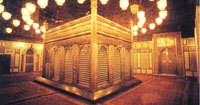
Advertising in Yemeni Press [Archives:1999/05/Culture]
February 1 1999

By:
Faisal Farhan,
Sanaa University Student
This article is a summary based on field research and interviews I did as part of my academic requirements at the College of Journalism at Sanaa University. I investigated the nature, structure, and significance of advertisements in the Yemen press. I covered three categories of newspapers based on ownership – government-owned; political party-owned; and independent newspapers.
Early Advertising
Fatat Al-Gazeera was the first newspaper to run advertisements. That was in the 1940s in Aden. The first items to be advertised were skin ointment, cigarettes, and beverages. Advertisement of other products followed later.
It should be said that freedom of the press in Yemen was really achieved after the country’s re-unification in 1990. Since then, both readers and sponsors of advertisements have exercised some options in terms of choice.

But the real advertising business in Yemen started with the Yemen Times. Since its birth in February 1991, this paper has set the pace, direction, standards, and even rates for advertising. Many newspapers today even imitate its format and style.
The Yemen Times also achieved another record by becoming the country’s first paper to be published in full color.
Advertisement Importance
For official newspapers, revenue advertising doesn’t usually play a vital role in the continuation of issuing the paper. As mouthpieces of the state, they are supported by the government no matter what the market assessment of their performance. The same is true of newspapers representing political parties. Their agenda calls for promoting their ideals and ideas, and not for meeting market demand. Therefore, revenue from advertising is an additional bonus which is used to improve the income of the editorial and managerial staff of the papers.
Advertising is, however, the lifeline of independent newspapers. This is visible from the situation of the Yemen Times, to which advertising income represents nearly 80% of total revenue. That also reflects the importance the paper attaches to market trends and inclinations, as well as the pro-business orientation of the paper.
Advertisement Income
The official papers have the lion’s share since they are easily distributed in all governorates. They are also available in all government bodies. That is why most advertisements go to these papers.
The independent papers receive the second highest volume of advertising business. This is because they have earned it, and because of the readable material they carry. In addition, they are characterized by easy distribution and colorful pictures and advertisements.
Newspapers controlled by political parties carry few advertisements. This is particularly true in the case of opposition papers. Sponsors, especially businesses, don’t want to be associated with them.
Advertising Differences
The official paper now tries to use a complete system of computers and specialized administration in advertising so that advertising could be done in a better way. The party paper also tries to make use of the new programs and techniques in computer science. The national paper has a highly qualified and experienced staff. It also makes agreements with the advertiser when styling and organizing advertisements. This is all done according the modern systems available to the paper.
Advertisement Designs
The official papers have specialized advertisement designers but most of them rarely have any experience. The party papers have no designers. Most of the advertisements are simply lumped into the space allocated for the purpose.
The best design specialists are in the independent newspapers. At the Yemen Times, there are three specialists.
This helps their efficiency and competence, which are two main criteria in these papers. This factor alone is one of the strongest appeals of the independent papers to patrons.
This also goes hand in hand with the computer hard- and software facilities of the papers. Here too, independent papers stand out.
Advertising Shaping
There is no real difference among the papers regarding the shape and message of advertisements. But, the independent papers try to make their advertisements more colorful and attractive, in order to be distinguished.
The language of advertisements in the newspapers depends on the type of the advertisement. We can distinguish among three groups:
1. Occasion-oriented advertisements which have become a big business nowadays is almost standardized. On a religious or national occasion, a lot of people wish the leadership success.
2. Marketing products or services is a second group of advertisements. Usually the wording and shape of the advertisement is determined by the sponsor or company. In many cases, especially regarding international trademarks, a ready-film is provided to the newspapers.
3. Vacancy advertisements is the third variety. Here, the text is supplied but the shape of the advertisement is left mostly to the newspaper.
There are, of course, other types of advertisements.
Conditions
In the official papers, there are some conditions. Advertisements should not deviate from local traditions, Islamic ethics and the political tendency of the regime. That is why, some hotel advertisements regarding musical and dance entertainments, for example, have to be re-structured. This is especially true of any pictures included.
In the party and independent papers, the controls are less stringent, and they are non-existent regarding political appropriateness vis-a-vis the regime. The advertiser faces few conditions, unless the advertisements openly go against local traditions, religious principles, or ethics. The Yemen Times once received an advertisement from a hotel which announced the offer of a free glass of wine for all new guests during a certain holiday season. After consultations, the paper advertised that the hotel was offering a free drink to all new guests during the said period.
Advertisement Impact
For the official papers, advertisements fill a space, and whether they are effective or not is irrelevant. Most of the times, the advertisement simply come to them for other reasons than impact.
The political party papers are similarly supported by sympathetic sponsors.
It is in independent papers that the sponsors review the impact of their advertisements regularly. That is why these papers often run readership profiles and surveys. Independent papers are more effective. This can be noticed in the increased volume of advertisements. “Advertisements actually have a considerable effect on Yemeni readers. The impact can be visibly noticed,” said Dr. Mohammed Abdul-Gabbar Sallam of the Faculty of Journalism.
Conclusion
We can conclude that the advertising business has witnessed tremendous progress. It has grown very quickly in all newspapers.
It has progressively changed in substance and style. It has became colorful and attractive using pictures. Competition among newspapers will continue to upgrade the advertising business in the future.
——
[archive-e:05-v:1999-y:1999-d:1999-02-01-p:./1999/iss05/culture.htm]


